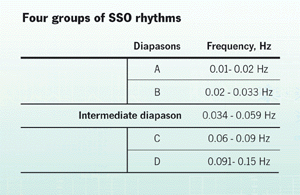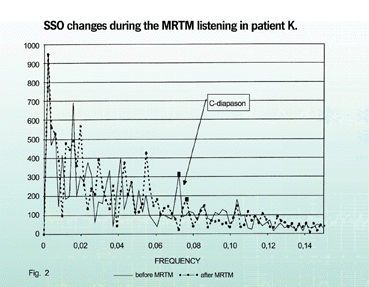Peter Hübner
Developer of the University
Medical Music
Preparations on CD
| . | |||||||||||||||||||||||||||||||||||||
| Harmonizing Autonomous Innervation of Cerebral Arteries |
|||||||||||||||||||||||||||||||||||||
Can the Medical Resonance Therapy Music® affect Autonomous Innervation Alexei V. Shemagonov, M.D.
|
|||||||||||||||||||||||||||||||||||||
| Abstract | |||||||||||||||||||||||||||||||||||||
To investigate the effects of Medical Resonance Therapy Music® (MRT-Music) upon autonomous innervation of cerebral arteries we studied slow spontaneous oscillations of cerebral blood flow (SSO) by transcranial Doppler ultrasound (TCD). TCD notices SSO with 3-9 cycles per minute (M-waves) and 0.5-2 cycles per minute (B-waves). |
The SSO are caused by rhythmic diameter changes of the medium and small cerebral arteries. Six patients aged 24-65 years suffering from tension headache were treated with MRT-Music®. Twelve further patients were examined with TCD only to register SSO for further spectral analysis. |
||||||||||||||||||||||||||||||||||||
After fast Fourier transformation we registered four groups of peaks on the SSO spectra, divided into four rhythms:
|
|||||||||||||||||||||||||||||||||||||
Spectral analysis of the SSO showed changes between initial and final amplitude peaks in all patients. In
contrast to A-, B- and D-rhythms the reduction of peaks in the C-diapason was statistically significant |
(31-60%, P=0.04, CI=95%) during listening to the MRT-Music®. All patients treated with the MRT-Music® reported a relief of headache while and after treatment. |
||||||||||||||||||||||||||||||||||||
| Conclusion | |||||||||||||||||||||||||||||||||||||
SSO may represent an equilibrium in autonomous innervation of the cerebral arteries. The MRT-Music® affects the functioning of the brain structures concerning autono- |
mous nervous system and works as a non-chemical
sympatholythic. Registration of the SSO is a useful tool to prove an influence of the MRT-Music® upon the autonomous regulation of cerebral vessels. |
||||||||||||||||||||||||||||||||||||
| Introduction | |||||||||||||||||||||||||||||||||||||
Alteration in cerebral arterial tonus frequently underlies many types of headache. It is interesting to note
that the cerebral arteries are less open to pharmacological interference than the other vessels in human
organism. However, the cerebral arteries are plenty innervated with perivascular autonomous nervous plexus.
The sympathetic part of the autonomous nervous system represents mainly cerebral vascular effects. But how can we modify an activity of the cerebral vasomotoric nuclei? Are there any alternative methods except chemical drugs? In 1964 the classical composer and musicologist Peter Huebner started to perform research into the microcosm of music. |
In 1987 the Medical Resonance Therapy Music® was developed by him for medical purpose on the basis of this more than 20 years of musicological research and under the inspiration of the ancient music medicine of Pythagoras, who stated that the harmony laws of the microcosm of music are also the harmony laws of biological life. Since then medical experts of different disciplines have found wide and successful clinical application of this Medical Resonance Therapy Music®. Most of the periodic processes in nature as well as in human organism are under the influence of the law of harmony. As chronomedicine shows even many processes considered to be sporadic are actually periodic. Finding the harmony law of human brain activity and correcting undesirable or “disharmonious” rhythms is a possible way to relieve some psychosomatic illnesses and some neurological diseases. To investigate the effects of MRT-Music® upon the autonomous innervation of cerebral arteries we decided to study the so called slow spontaneous oscillations of cerebral blood flow (SSO). |
||||||||||||||||||||||||||||||||||||
| What are SSO? | |||||||||||||||||||||||||||||||||||||
In 1982 Rune Aaslid has put transcranial Doppler ultrasound (TCD) into clinical practice. This method allows
to measure blood flow velocity in basal cerebral arteries non-invasively without any harmful effect for
a long period. While monitoring arterial blood flow velocity we can see the waves in velocity trend with
an amplitude of about 10-30% of the mean velocity. These waves are named slow spontaneous oscillations (SSO).
Some investigators notice SSO with 3-9 cycles per minute (M-waves) and 0.5-2 cycles per minute (B-waves)
[1]. They are convinced of the SSO being caused by physiological rhythmic diameter changes of the medium
and small cerebral arteries [2]. |
The origin of these rhythms is supposed to be some brain stem nuclei. The curve of cerebrospinal fluid pressure
also shows the so called B-waves within 30-120 seconds periods. The SSO are synchronized with intracranial
pressure waves. The cause of fluctuating of intracranial pressure is suggested to be the oscillation of
the diameter of cerebral vessels [3]. The wider the vessels diameter the higher is the level of intracranial
pressure. The physiological purpose of SSO hitherto is not fully explored. |
||||||||||||||||||||||||||||||||||||
| Patients and Methods | |||||||||||||||||||||||||||||||||||||
Six patients aged 24-65 years (2 males and 4 females) suffering from tension headache were enrolled in this study. The patients were treated with the music preparation RRR 931 of the Medical Resonance Therapy Music®. All these patients were examined by transcranial Doppler to exclude cerebral artery diseases and to monitor peak blood flow velocity in the middle cerebral artery while they were listening to the music preparation. None of them had any neurological disease. Twelve patients suffering from different neurological diseases excluding severe cerebrovascular diseases and stroke were also examined with transcranial Doppler only to monitor cerebral blood flow velocity and to register the slow spontaneous oscillations for further spectral analysis. |
Right middle cerebral artery (M1-segment) was selected for monitoring in all patients. We are convinced of the fact that a peak velocity reflects the diameter of the vessels better than a mean velocity. We used Trans-Link 9900, Rimed Ltd. and Intra-View, Rimed Ltd. transcranial Doppler systems. Doppler monitoring has been performed for 10 minutes in six patients who underwent the MRT-Music® treatment as well as in the other monitored patients. Doppler monitoring was started in the 10th minute of the MRT-Music®. Spectral analysis of SSO has been performed by means of Microsoft Excel fast Fourier transform tool (sample size – 1024). Differences between groups were analyzed using t-test with 95% confidence interval (CI). |
||||||||||||||||||||||||||||||||||||
|
|||||||||||||||||||||||||||||||||||||
Results In both groups of patients transcranial Doppler showed no evidences of occlusive and stenotic arterial diseases. All the patients have revealed the slow spontaneous oscillations of peak and mean velocities. After the fast Fourier transformation we have seen several groups of peaks on the SSO spectra (Fig.1.), which may be divided into four rhythms A,B,C, D and intermediate diapason (Tabl.1.) Frequency of A- and B-diapasons corresponds to well known B-waves. Frequency of D- and C-diapasons corresponds to the above mentioned M-waves. Intermediate diapason lies between B- and C-diapasons. Amplitude of peaks in the A- and B-diapasons prevails over the other peaks. Spectral analysis of the SSO has shown changes between initial and final peaks amplitude in all patients, where reduction of peaks in C-diapason during the MRT-Music® listening was statistically significant in contrast to A-, B- and D-rhythms. (Fig.2.; Table 2.) No significant changes in heart rate, breath rate and blood pressure level have been revealed while transcranial Doppler monitoring. Moreover, the patients complaining of headache before the MRT-Music® course had a headache relief after.
Since it is not quite clear what the pace-maker of SSO rhythms is, we consider that the Medical Resonance Therapy Music® affects the functioning of some brain structures concerning the autonomous nervous system. |
    |
||||||||||||||||||||||||||||||||||||
It is possible that the MRT-Music® affects these structures by means of cortex activity regulation. Our previous study revealed augmentation of C-rhythm during smoking. Taking into account the activation of sympathetic nervous system during smoking we suppose that the C-rhythm increase is a sequela of imbalance between parasympathetic and sympathetic innervation and predominance of the sympathetic activity. In contrary to nicotine the MRT-Music® induces the modification in the opposite direction. Thus, we cautiously suppose that the MRT-Music® affects the autonomous regulation of the cerebral vessels as non-pharmacological sympatholythic. The MRT-Music® regulates the tonus of the cerebral vessels by means of strengthening the equilibrium between the parasympathetic or sympathetic activity. Taking into account the significance of the imbalance of the autonomous nervous system in some neurological diseases, especially in some forms of headache, the MRT-Music® may be widely used in clinical practice. Moreover, registration of the SSO is a useful tool to explain positive effects of the MRT-Music® and to prove the influence of the MRT-Music® upon the autonomous regulation of cerebral vessels. Further investigations are needed to clarify MRT-Music® effects on the SSO. We are also going to try various types of the MRT-Music® courses for the SSO and to compare them with some pharmacological tests. |
|||||||||||||||||||||||||||||||||||||
Conclusion
References
|
|||||||||||||||||||||||||||||||||||||
| DEUTSCHE AKADEMIE DER KREATIVITÄT |
| DEUTSCHE AKADEMIE DER KREATIVITÄT |
| SCIENTIFICALLY INTRODUCING UNIVERSALITY TO ACADEMIC LIFE |
| Faculties: Music & Musicology · Philosophy · Medical Sciences · Education · Pythagoras · Consciousness · Humanities · Natural Science · The Dragon · The Veda · Culture · Opera & Arts |
| . |
. | .Deutsche Übersetzung in Arbeit |
| peter huebner • micro music laboratories |
| M E D I C A L R E S O N A N C E T H E R A P Y M U S I C ® |
| R E D U C T I O N O F P S Y C H O – P H Y S I O L O G I C A L M A N I F E S T A T I O N S O F S T R E S S |